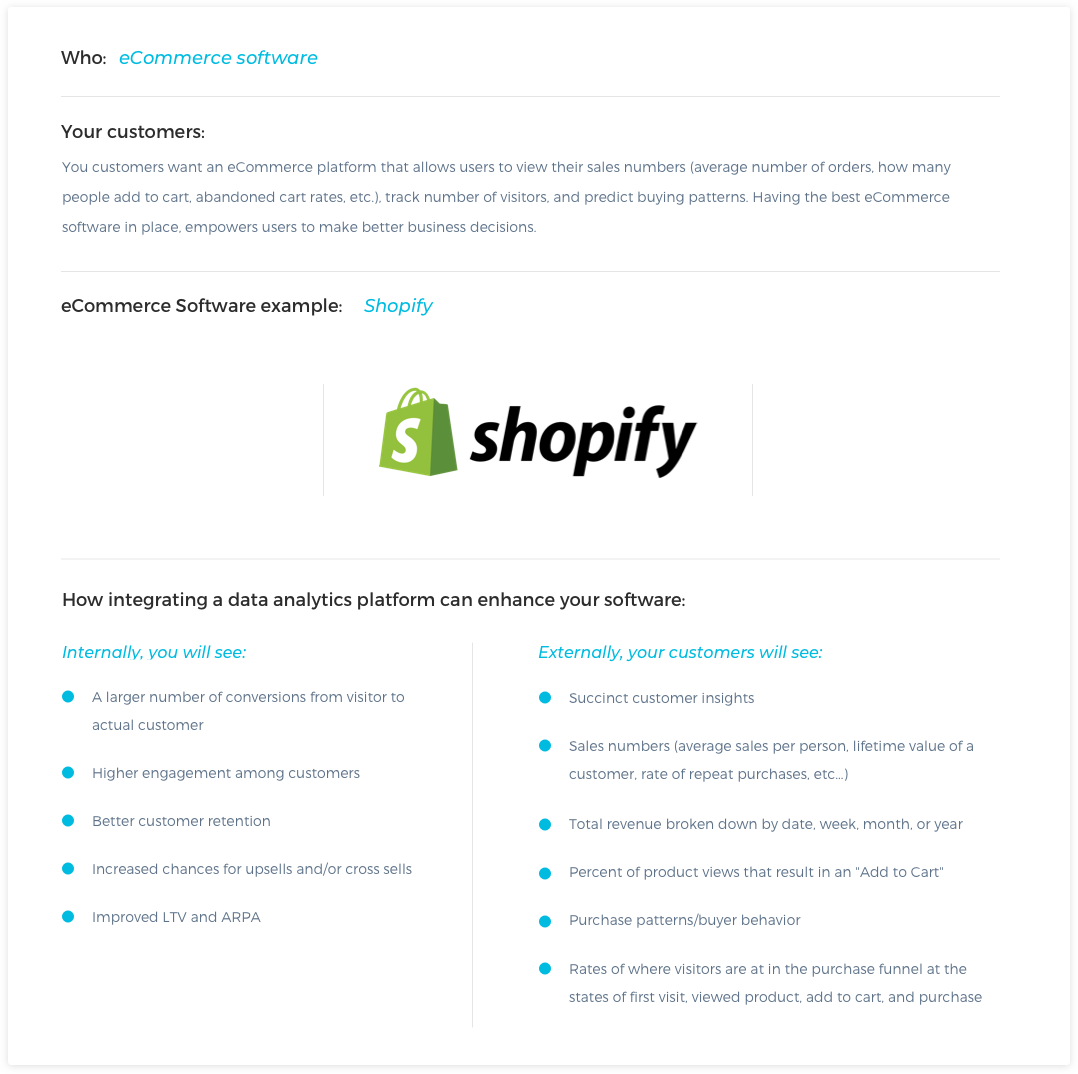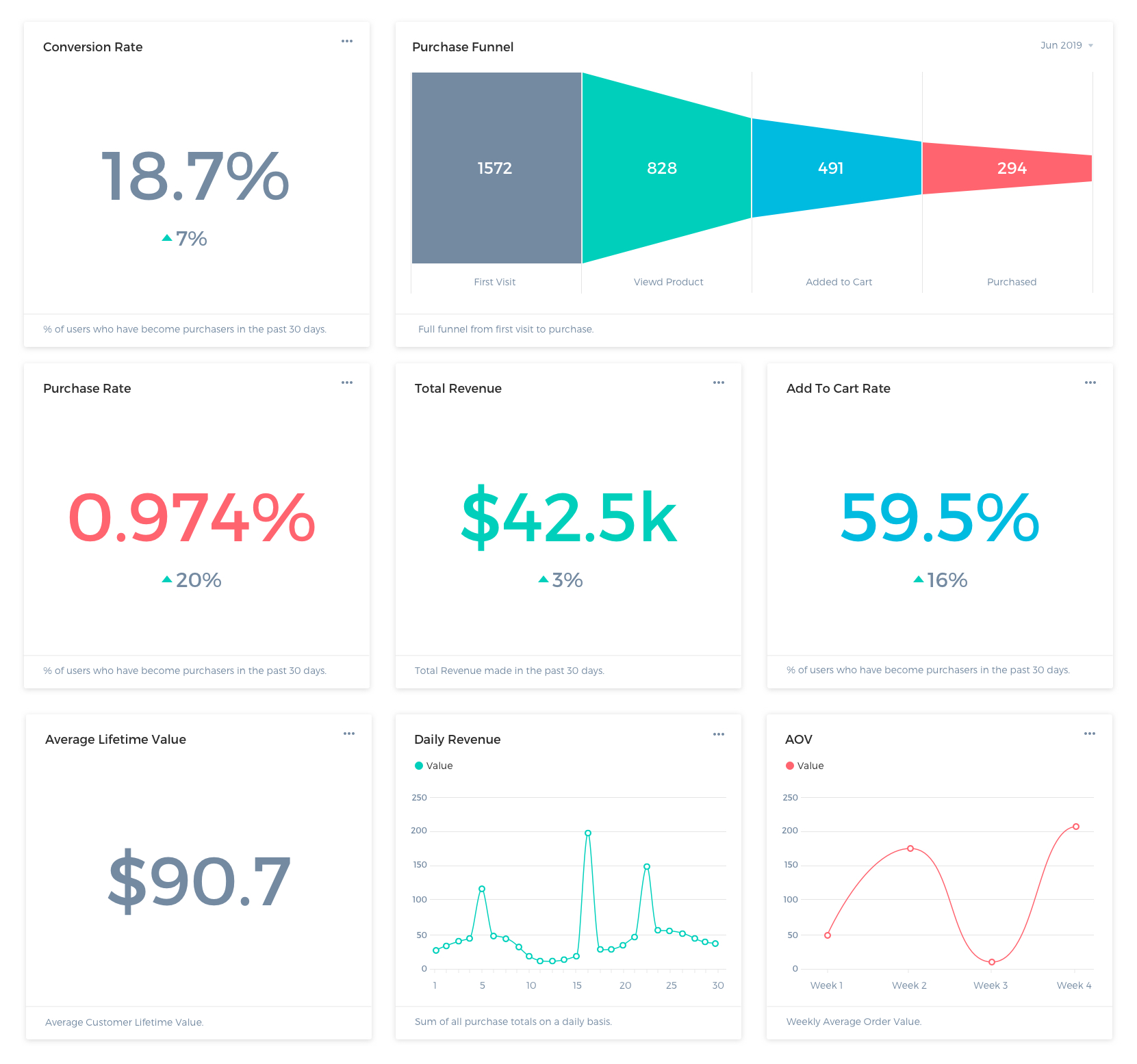According to Statista, “In 2021, over 2.14 billion people worldwide are expected to buy goods and services online, up from 1.66 billion global digital buyers in 2016.” In other words, the eCommerce space is still booming, it shows no signs of slowing down, and it has big potential for service providers related to all aspects of the eCommerce industry.
If you’re building eCommerce software, there is no time like the present to complete your product, and hopefully cash in on the trend. However, even if you are just getting into the eCommerce game, it’s more critical now than ever that you provide your customers with software that can help them take their businesses to the next level. One way to help them is by integrating customer-facing metrics into your platform.
What does this mean and why is it important to your customers?
Customer-facing metrics are all the numbers and data connected to usage and performance, delivered seamlessly on the front end to your customers to enhance the user experience. These metrics offer a visual representation of the value of your product, as well as how customers and users are engaging and interacting with it.

Current Challenges eCommerce Store Owners Face
With most eCommerce software solutions, the idea is to give online shoppers the ability to quickly purchase goods and services at any time – day or night. After all, “The number one reason people shop online is that they’re able to shop at all hours of the day.” Therefore, it is imperative that when a user visits a store, the purchasing experience is a seamless process from visit to completed sale.
What your eCommerce software customer needs is real-time, or near-real-time, data and metrics shown to them in a way that is actionable. It should look and feel like the rest of the application, while at the same time provide them with a way to track conversion rates, make more sales, take advantage of buyer behavior, and more.
Goals
The goal of your eCommerce software is to provide your customers with actionable dashboards filled with analytics of traffic and sales to gain insight into their store’s growth. The more usable information they receive, the better choices they can make for their businesses.
10 eCommerce Metrics You Should be Tracking
Trust us, your customers will soar past the competition when inside data is presented to them in an easy to understand visual format. With metrics such as the ones outlined below, they will have no choice but to optimize their shop to better accommodate their buyers.
By putting yourself in your customers’ shoes, you’ll find that at a minimum, the customer-facing metrics built within your eCommerce software should include data reporting on things like:
- The website/referral url the user arrived at the storefront from: How did they find you? Are there avenues that should be explored for new or additional advertising opportunities?
- When people are buying: What time of day are people purchasing most?
- What the rate of sign-ups is: How many people are subscribing to the mailing list? Has there been an influx or decline of new signups recently? Should we offer a discount to subscribe?
- Current conversion rates from visitor to customer: What percentage of store visitors have become purchasers? How does this compare to last month?
- The rate of people that add products to cart: Percentage of product views that result in an add to cart.
- The rate of people that abandon their cart: How many people are abandoning their cart with items inside? You should have some outreach in place to remind them of their pending purchases, or create an auto-save feature where upon their next store visit their cart is still populated.
- Number of completed purchases: How many actual purchases have you received within the given time frame?
- The rate of people that will purchase again: Percentage of customers that have made repeat purchases.
- The average value of orders: Broken down on a weekly basis, what is the average order value.
- The average lifetime value of a customer: How much on average is each customer worth.

Take a look at our live example!
We’ve created an interactive version of the above dashboard to accompany our demo store. In here you will see the metrics come alive in real time.
Data like this will not only help your customers make better business decisions, but it will also allow them to:
- Identify top-performing products
- Identify upsell opportunities
- Launch retargeting campaigns
- Deliver a personalized shopping experience
- Keep shoppers engaged
By helping your customers capitalize on consumer interactions using product engagement analytics and buying behaviors, they will understand exactly how their shop is performing and where to improve.
Embedding Customer-Facing Metrics Into Your eCommerce Software
Hopefully, at this point you’re aware that there is a need for these types of customer-facing metrics in your eCommerce software. If so, now what? Well, now you need to create and implement them, all the while ensuring that the data is easy to interpret and actionable.
Once you start looking into implementation, you’ll find you have two viable options:
- Build your in-application analytics solution from scratch
- Buy a ready-made product, and implement
Build your in-application analytics solution from scratch
You could hire a team of engineers and application developers to build an analytics solution from the ground up. This may mean shelling out hundreds of thousands of dollars, or more, for the build. By choosing this option, you will have complete control over the solution you create. And, you will also have the ability to manipulate the ways data is displayed, and even how it’s queried.
Your team may thoroughly enjoy building a solution in house, and it can certainly boost the CV of anyone involved on the project. What you need to ask yourself though, is whether or not an in-house build is the most viable option for your company.
Consider the following:
1. Are there other things you and your team should be working on instead? There is a significant opportunity cost involved with a ground up build like this.
2. Will the completed solution fully address the needs of you and your end users? In some cases software developers shell out time and resources only to be left with brittle, inflexible, and/or subpar solutions that are not future proof. Meaning, they may be faced with the need to build another solution from scratch all over again sometime down the road.
3. Finally, do you have all the required resources in place that you need to complete a build like this? From staffing qualified individuals to having the right resources on hand, you might realize you don’t have everything in place to set up your solution correctly.
Buy a ready-made product, and implement
The alternative to building your own solution from scratch that many software developers choose is buying a ready-made product. There are pros and cons to this option as well that you must consider before your purchase, however.
Pros:
- It should be ready to implement almost as soon as you buy it
- It will be significantly cheaper than the alternative
Cons:
- Ready-made options are often significantly limited in terms of function and usability
- Many, if not all, ready-made options are lacking in terms of the customer-facing metric your customers may need/want
What do you do if neither of the above options don’t work for you? Is there a happy medium? Luckily, the answer is YES!
Insert Keen, the embedded analytics API that gives software developers the ability to build customer analytics solutions into their programs in less time and with less resources. By combining your eCommerce software with Keen’s platform, you’ll get a custom solution that will be perfect for both you and your customers.
Both your software customers, and their users are already demanding visual information that they can understand and use to grow and scale their businesses. Give them what they want, and you’ll be ahead of your competition.
Working with Keen is so simple, you’ll wonder why you didn’t do it sooner. Simply bring your mock-ups to us, and we can help you create a front-end experience and data model that is designed to your specific needs. In fact, you don’t even need a mock-up to get started. Keen’s data visualization experts can help you develop a beautifully impressive dashboard for your customers.
Next, we’ll help you with the customization of your in-product analytics, and we’ll help you seamlessly integrate them into other applications and platforms already in existence. We won’t stop there either. After we’ve successfully helped you embed custom metrics, our team of developers and experts will manage the maintenance to ensure that product dashboards continue to operate correctly.
Working with Keen is the easiest, and most cost effective way to provide a powerful analytics solution within your software. Imagine design being as simple as copy and paste, and getting a competitive edge over other software companies on the market. The best part is Keen’s designers and engineers will be on hand to assist in every aspect of the development. There is no down side!
Your customers need in-application data and reporting. We help you give it to them faster. But, don’t take our word for it. Request your demo now!




